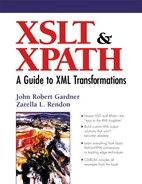Preface
You've heard of XML; your manager wants you to use it in your applications. Now what?
You've used HTML, and you know what a tag is; you know that it is somehow related to XML. You may even know what XML is and what it does. What you may not know is that, while XML identifies and adds structure to the content of a document, it does not tell you anything about how to process that content, or how to do anything useful with it beyond storage. This is good news, because this means your content can be used for many different purposes.
There are many things you can use to process content once it is marked up using XML. However, we have chosen to talk about the only standard application that allows you to do many different things with it. With XSLT, you can add style to XML, convert it to other XML, or simply chop it up and regenerate it in a different form.
XSLT is the power behind the throne of XML. It assures that every level of every piece of XML data is accessible and reusable across platforms and forward in time. It is not an exaggeration to say that XSLT and its companion XPath are the very glue and mortar that hold together and build the endlessly varying applications of markup data for any industry, academy, or individual. XSLT is the fastest cure for the fear of having obsolescence in a data or information architecture design.
XSLT is easy to use. In fact, XSLT itself is XML. XSLT “speaks the language,” or the syntax, of XML with a powerful vocabulary of programming-like features that are nonetheless easy to use, learn, and understand.
XSLT attempts to be a bridge to nonprogrammers, bringing the easily understood syntax of XML together with a powerful scripting mechanism and simple pathing approach to document navigation.
It is our belief—and our approach in writing this book—that both the experienced programmer and the newly trained markup technologist can become more comfortable with the potent set of tools for preserving, augmenting, updating, and delivering XML data—whether it's on the Web or your corporation's intranet or B2B.
If you are constantly wishing you had just a little more control over your information, this book will deliver that—and much more. In fact, by the end of the first chapter, you will be able to perform basic conversions from XML documents to HTML that will display in any Web browser. Subsequent chapters build upon and enhance that base of knowledge, matching examples with detailed explanations and providing focus upon commonly misunderstood areas.
When you read this book, have your computer handy. Take the time to load up one of the XSLT processors and work along as you read. Learning by doing is always best, especially with XSLT and XPath. Chapter 13 will show you how to install the software included on the CD. Each example in the book is found on the CD in the examples directory, organized by chapter.
XSLT is rewarding and creative to use. Be prepared to enjoy this learning experience. You will be surprised by how quickly productive use of this technology increases.
